
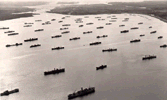
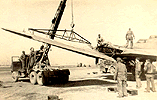
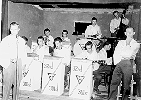


To send an e-mail message to Boyd Thompson about the 32nd Bomb Squadron, 1942 -1945, or its members,
![]()
WHEN THE GOVERNMENT began flying the mail, the 32nd had a large part in the program operating them out of Salt Lake City, Utah. During the B-10 era, maneuvers were held all over the country from Florida to the State of Washington and California. Among the squadron commanders in those earlier days were Captains Pyle, Heisen,Ridenour, D. Fitgerald and Majors Grisham, Peck, Eubank and A. Y. Smith. Some of these men commanded the outfit while it was with the 19th Bomb Group at March Field, California. From October of 1935 to June of 1941 the 32nd flew operational, navigational, cross-country and practice bombing flights out of March Field. In that month it moved via POC to Albuquerque, New Mexico under the command of Major Tate.
IN SEPTEMBER OF 1941, the 19th received orders to proceed to Clark Field, Manila in the Philippines. The 32nd as the senior squadron was to stay behind for a short period to clean up the administrative details and straighten out the records of all its transfers of personnel to the other squadrons of the group. It was to replace its vacancies with new personnel. Although the 32nd was supposed to rejoin the 19th Bomb Group at Clark Field, the two outfits never again got together because of the events of the coming war.
THE OTHER THREE SQUADRONS that completed the 301st Group were the 352nd, 353rd and the 419th. Major John T. Cox was in command of the 32nd when it left Geiger Field for Almagordo, New Mexico on May 25th 1942. The air echelon meanwhile flew into Muroc Dry Lake, California on June 5th. The two echelons met at Almagordo for one day and then separated. 1st Lt. Marvin D. Fleming was appointed acting commander of the Ground echelon and on June 18th left by train for Richmond Army Air Base in Virginia.
THE GROUND ECHELON arrived in Richmond on June 21st (Father's Day) and began its preparation for overseas service with packing and getting all the necessary vaccination shots. While the ground echelon was sweating in the hot Richmond weather the air echelon flew into Hartford, Conn. and then onto Westover Field, Chicopee Falls, Mass. From there it flew cross-country and submarine patrol until July 28th. On July 20th the ground echelon left Richmond for Fort Dix, New Jersey. It remained there for two and a half weeks drawing equipment, taking shots and physicals, getting acquainted with a rifle, hearing briefing lectures and going over the fence to Trenton.
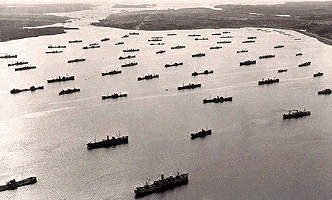 THE 32ND LEFT THE UNITED STATES for the third time on August 6, 1942, having formed-up with a convoy in Bedford Basin, Halifax, Nova Scotia, and proceded to England. While the ground echelon was tossing on the North Atlantic in the "USS Uruguay" and making it's way to Chelveston, Northamptonshire, England via disembarkation at Swansea, Wales on August 18th, the air echelon was also heading for Europe. Between the 22nd and 26th of July it moved to Presque Isle, Maine and they was assigned to fly weather for the largest convoy that had ever left the States by that time. The 32nd and the 301st was a part of that convoy. The weather patrol was accomplished in four sections; Presque Isle to Good Bay, Newfoundland; Goose Bay to "BW-1" and "BW-8"; Then to Reyjavi, Iceland and Iceland to Prestwick, Scotland.
THE 32ND LEFT THE UNITED STATES for the third time on August 6, 1942, having formed-up with a convoy in Bedford Basin, Halifax, Nova Scotia, and proceded to England. While the ground echelon was tossing on the North Atlantic in the "USS Uruguay" and making it's way to Chelveston, Northamptonshire, England via disembarkation at Swansea, Wales on August 18th, the air echelon was also heading for Europe. Between the 22nd and 26th of July it moved to Presque Isle, Maine and they was assigned to fly weather for the largest convoy that had ever left the States by that time. The 32nd and the 301st was a part of that convoy. The weather patrol was accomplished in four sections; Presque Isle to Good Bay, Newfoundland; Goose Bay to "BW-1" and "BW-8"; Then to Reyjavi, Iceland and Iceland to Prestwick, Scotland.
IN ADDITION some of the 32nd ships were assigned to patrol the St. Lawrence River and some to convoy duty over the water movement. After the convoy was safely in England without the loss of a ship the planes rejoined the ground echelon at Chelveston on September 19, 1942. This was a merry day for the weary ground personnel who were thoroughly tired by then of shuttling around from location to location. Because of the delayed arrival of the planes the 32nd made its first mission on October 2nd and flying four more before the English weather grounded them.
THE FIRST CASUALTY occurred on the mission of November 8th against Lill, France when T/Sgt. Edward C. Grabowski was wounded in the leg by flak. Not one person was killed or were missing during their stay in England. The infamous English late fall weather gave concerned most of the time to do nothing.
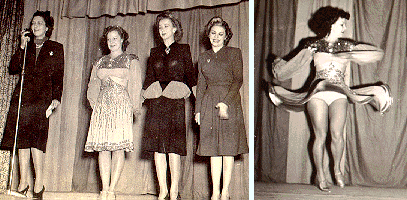 TRIPS TO LONDON on three-day passes were arranged and were universally put to good use. The four Jills including Martha Raye, Carole Landis, Kay Francis and Mitzi Mayfair put on a great show for the men. King George V1 visited the field and Corporal Joe Bochenek was credited with having told the King off about the "lousy English weather". A new record for the number of times a bomb load could be changed before take off was established.
TRIPS TO LONDON on three-day passes were arranged and were universally put to good use. The four Jills including Martha Raye, Carole Landis, Kay Francis and Mitzi Mayfair put on a great show for the men. King George V1 visited the field and Corporal Joe Bochenek was credited with having told the King off about the "lousy English weather". A new record for the number of times a bomb load could be changed before take off was established.
CAPTAIN EDWARD F. STODDARD Captain Edward F. Stoddard of the 419th squadron took over command of the 32nd replacing Major Cox who was transferred to the then forming 12th Bomber command on October 24, 1942. The North African invasion was in full swing so the air echelon took off from Chelveston, stopping at Hurn, England and later landing at Tafaraoui Airdrome near Oran, Algeria on November the 24th. They flew their first mission on the 28th of November against the docks at Bizerte. They lost their first ship, "The Bad Penny" piloted by Captain John B. Bruce the squadron operations officer to fighters that were aiming at another ship that had pulled out of formation. The Bad Penny was seen to crash in the sea with all aboard.
FROM TAFARAOUI the air echelon moved to Maison Blanche, outside Algiers on December 6th.. From there they continued operations against targets in Tunisia in company with the rest of the 301st. The Bizerte mission was made alone by six ships of the 32nd. The 32nd air echelon then moved to Biskra, an oasis on the edge of the Sahara desert on December the 13th. It was here that Rommel's JU-88s, occasionally reinforced with Stukas started their highly concentrated attacks. T/Sgt John Dorosinsky was the only man in the outfit to get wounded during these attacks. He caught shrapnel in his back on two occasions for which he received the purple heart with a cluster.
THE ADVANCED GROUND ECHELON left Chelveston on November the 26th and boarded the "Duchess of Bedford" and "HMS Toranto" the next day at Liverpool. The ships were to dock at Oran but instead went to Algiers and remained in the harbor for two days and nights. The ships then steamed back to Oran and discharged the remainder of the advanced echelon on December 8th. The rest of the ground echelon started on its way to Africa by train after leaving the station at Higham Ferres on December 8th. The next day they boarded the "Duchess of Richmond". The rest of the convoy left on December the 9th but the "Duchess" was delayed until the 12th because the anchor cable was fouled by a sunken ship in the harbor. The Duchess was forced to run through the out of bounds minefield that was the Saint George channel and sail for three days and nights with only one destroyer as escort in trying to catch up with the rest of the convoy. It was successful and on December the 21st the 32nd unloaded at Mers-el-Kebir, a small port outside of Oran. After a three mile hike up a long hill in the boiling sun with full packs they boarded trucks for their trip to their new home. It was a barren soggy hill later called "mud hill" due to the December and January rains.
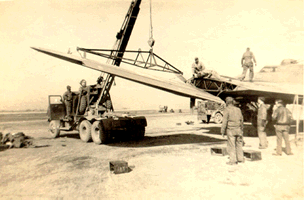 THE 32ND BOMB SQUADRON was very active in the North African campaign in 1943. In the photo at left Air Mechanics are replacing the wing of a B-17 that was damaged by flak in a raid over Gabes, Tunisia, in North Africa. The Crew Chief in charge of this repair was T/Sgt. Kenneth A. McIntosh, far right. Planes that were damaged beyond repair were used for spare parts.
THE 32ND BOMB SQUADRON was very active in the North African campaign in 1943. In the photo at left Air Mechanics are replacing the wing of a B-17 that was damaged by flak in a raid over Gabes, Tunisia, in North Africa. The Crew Chief in charge of this repair was T/Sgt. Kenneth A. McIntosh, far right. Planes that were damaged beyond repair were used for spare parts.
AFTER A MONTH'S STAY the ground echelon entrained at St. Barge on January 21st and arrived several days later at Ain M'Lila, an airfield near Constantine, Algeria. The air echelon arrived the same day so on the 21st there was a joyous reunion for the 32nd squadron.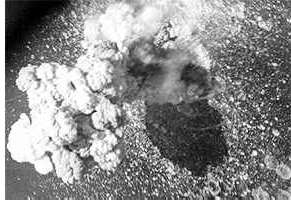 Cold weather set in and a snowstorm put the finishing touches on life in a pup tent. It was here that operations began in earnest as a result of the three echelons having joined forces. The outfit lost a new crew and plane on their first mission. The only veteran aboard was Captain Broderick, the pilot. Missions continued from there for almost six weeks but on March 6, 1943 the 301st moved to a different mudhole about 45 miles the other side of Constantine. This base was located at St. Donat and was fairly permanent so the Group remained there until August 6th of 1943. In conjunction with the 301st while at St. Donat the 32nd distinguished itself because of its part in the Tunisian, Pantellerian, Sicilian and a portion of the Italian campaigns. The entire list of serviceable aircraft was involved in the mission to attack an ammunition ship that was being rushed to Rommel's aid. The ship was sunk (right) and the 301st along with the 32nd squadron won it's first Presidential Citation.
Cold weather set in and a snowstorm put the finishing touches on life in a pup tent. It was here that operations began in earnest as a result of the three echelons having joined forces. The outfit lost a new crew and plane on their first mission. The only veteran aboard was Captain Broderick, the pilot. Missions continued from there for almost six weeks but on March 6, 1943 the 301st moved to a different mudhole about 45 miles the other side of Constantine. This base was located at St. Donat and was fairly permanent so the Group remained there until August 6th of 1943. In conjunction with the 301st while at St. Donat the 32nd distinguished itself because of its part in the Tunisian, Pantellerian, Sicilian and a portion of the Italian campaigns. The entire list of serviceable aircraft was involved in the mission to attack an ammunition ship that was being rushed to Rommel's aid. The ship was sunk (right) and the 301st along with the 32nd squadron won it's first Presidential Citation.
WHILE AT THIS BASE, on the 10th of April, the 32nd was dispatched with the 301st to attack the Italian heavy cruiser Trieste, which was anchored in a cove at La Maddalena, Sardenia, protected by anti-submarine nets. In a classic attack from 19,000 feet, shown below, direct hits with 1000-pound bombs sank the Italians' last heavy cruiser, leaving only the anti-submarine nets in view.
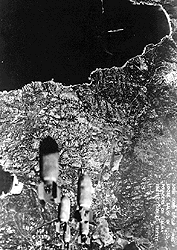
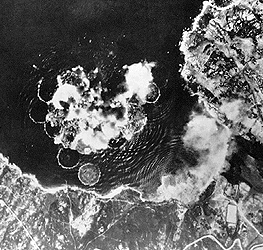
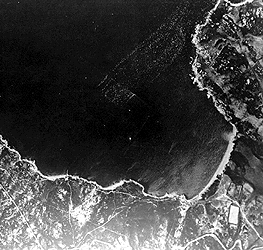
TO REACH TARGETS IN ITALY more easily, the organization moved to Oudna Number 2, an airdrome 16 miles from Tunis on the first anniversary day of their departure from the States. During their stay at Oudna the 15th Air Force was created and the 32nd was transferred on paper from the 12th Air Force to the 15th. The 15th flew its first mission on November 2nd against Wiener Neustadt, Germany and the news bulletins proudly pointed out that only four ships were lost on that initial attack. However, those four ships constituted the 32nd's worst loss to date. The 32nd sent six ships on this raid and the remaining two didn't return until the next day after stopping off for emergency repairs and running out of gas on the return trip.
MAJOR NEIL E. WALKER had assumed command of the 32nd in July of 1943 after Major Stoddard completed his fifty missions. Major William J. "handlebars mustache" Emerson had relieved Major Walker on September the 6th.
ON DECEMBER 2ND, 1943 the squadron began the move to Italy completing the process on December the 9th. Captain Jack W. Collins who had succeeded Major Emerson assumed command of the 32nd. The new station was Guilia Airdrome, Cerignola No 1, Italy. It was at this base that Captain Collins was succeeded as Commanding Officer by Captain Wilkie A. Rambo on December 12. One week later Captain Rambo was seriously wounded in the leg by flak over Innsbruck, Germany and Captain Collins assumed acting command until December 28th. Captain Robert J. Bosworth took his place to become the squadron's fourth commander within one month. After settling down at Cerignola, the 32nd continued to attack both strategic and tactical targets in Italy, France, Germany and the Balkans until February 3rd, 1944. It moved to Lucera No. 8 just seven miles north of Foggia to make way for a B-24 Group that the base was better suited for. Before the squadron left Cerignola Corporal Dillard was killed by a 500-pound bomb that was accidental dropped while loading a ship. Flight Officer Parker was disciplined for making a remarkable emergency belly landing, a feat which rivaled in proficiency Captain Casey's one engine landing with two flat tires at St. Donat. It was Flight Officer Parker's fifty missions as a Flight Officer.
AFTER A WEEK at Lucera the field's runway became unserviceable with mud due to the heavy rains and the squadron moved to Foggia Main, the hub airdrome of the satellite system the Germans had built around Foggia. We had attacked this same airdrome several times from bases in North Africa.
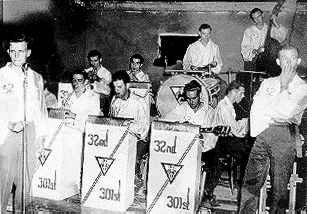 ON EASTER SUNDAY, April the 9th the group moved back to Lucera and began to improve the field and living area for its long stay. Numerous permanent and semi-permanent buildings were built including an Officer and Enlisted men's clubs. It was reported that the 32nd had the best permanent facilities in the group. It was here that the "32nd Flying Vagabonds", a 15 piece band of professional caliber was formed. With the aid of such superior musicians as Carl Garner, pianist, Bob Andrews, trumpet, Sam Kolodjiej, tenor sax, Bob Cameron, guitar, Elmer LaGassey, trombone, Lucien Taillac, alto sax and Brayton Coleman, drums won the Southern Italy Organizational band contest sponsored by Army Special Service.
ON EASTER SUNDAY, April the 9th the group moved back to Lucera and began to improve the field and living area for its long stay. Numerous permanent and semi-permanent buildings were built including an Officer and Enlisted men's clubs. It was reported that the 32nd had the best permanent facilities in the group. It was here that the "32nd Flying Vagabonds", a 15 piece band of professional caliber was formed. With the aid of such superior musicians as Carl Garner, pianist, Bob Andrews, trumpet, Sam Kolodjiej, tenor sax, Bob Cameron, guitar, Elmer LaGassey, trombone, Lucien Taillac, alto sax and Brayton Coleman, drums won the Southern Italy Organizational band contest sponsored by Army Special Service.
ON THE MORE SERIOUS side, some of the high spots of the Italian stay were the running battle over Regensburg, Germany. February 1, 1944 marked the group's worst loss of sixteen planes out of twenty two and on this occasion the Organization's second Presidential citation.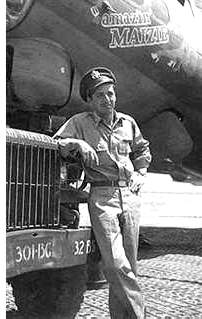 The conclusion of December in 1944 somewhat paralleled the events of the previous December. Lt. Col. Edwin F. Harding (right), who had assumed command on March 25 of that year completed his missions early in December. On December 23 he was succeeded by Major Donald W. Ewing the former squadron operations Officer. Major Ewing and his crew were lost in action on December 26th and Captain Wendell L. Beven Jr., a west pointer from the 353rd squadron was appointed Commanding Officer of the 32nd. Major Ewing and his crew all returned after a long trip back from behind the Italian lines via Cairo some weeks later. Among his gunners was S/Sgt. Everett C. MacArthur, a converted mechanic and orderly room clerk who was again shot down in April and given up for lost. He was imprisoned in Bologna and released and after a trip through the Brenner pass aboard a 5th army tank he returned to the squadron, the eve of V-E day on May 8th, 1945.
The conclusion of December in 1944 somewhat paralleled the events of the previous December. Lt. Col. Edwin F. Harding (right), who had assumed command on March 25 of that year completed his missions early in December. On December 23 he was succeeded by Major Donald W. Ewing the former squadron operations Officer. Major Ewing and his crew were lost in action on December 26th and Captain Wendell L. Beven Jr., a west pointer from the 353rd squadron was appointed Commanding Officer of the 32nd. Major Ewing and his crew all returned after a long trip back from behind the Italian lines via Cairo some weeks later. Among his gunners was S/Sgt. Everett C. MacArthur, a converted mechanic and orderly room clerk who was again shot down in April and given up for lost. He was imprisoned in Bologna and released and after a trip through the Brenner pass aboard a 5th army tank he returned to the squadron, the eve of V-E day on May 8th, 1945.
MISSIONS ENDED with the cessation of hostilities and after that time only a few missions of transporting food and clothing to Northern Italy, Austria and the Balkans. Most personnel were then being relieved of duty in the Italian theater and were transported back to the States. Those remaining packed up their belongings and turned the squadron over to the Quartermaster Corps. They then departed for the University of Naples at Bagnoli. From there they boarded a small banana boat in Naples on July 14th, 1945 and on the 25th docked at Hampton Roads, Virginia.
TAKING PART in this official return of the 301st to the United States was nine men who had originally gone over with the squadron in August of 1942. They had not been home on rotation or temporary duty. They lacked just twelve days of serving overseas for three years. From Camp Patrick Henry the men of the 32nd were sent to their several distribution centers for a thirty day rest, recuperation and rehabilitation leave carrying orders to report at the completion thereof to the 301st at Sioux Falls. But V-J day fortunately intervened and with only a few exceptions those men never saw Sioux Falls. Most were discharged by early September at their distribution centers and some with as high as 140 discharge points.
I PRESUME that the 32nd was inactivated once more after that and was reconstituted with a contingent of completely new personnel. My acquaintance with it ends in September of 1945, when I left the Service and went home. But there remains a quite justified feeling of pride in anyone who was a member of that remarkable outfit. And anyone who took part in the more than four hundred missions it flew against the enemy in three theaters of operation. Also those who were privileged to be a part of the tradition that grew out of the men who contributed to its distinguished performance in the air and on the ground. Men like Captain Colin P. Kelly, Captain John Sloulin, Captain Bruce, Captain Rambo, S/Sgt. Randolph Gwal and a host of others who did their best to add honor to the fighting career of the Thirty-Second Bombardment Squadron, Heavy of the United States Army Air Corps, a truly great outfit. I hope that we will be adding to and perfecting this history of the 32nd Bomb Squadron during WWII.